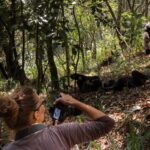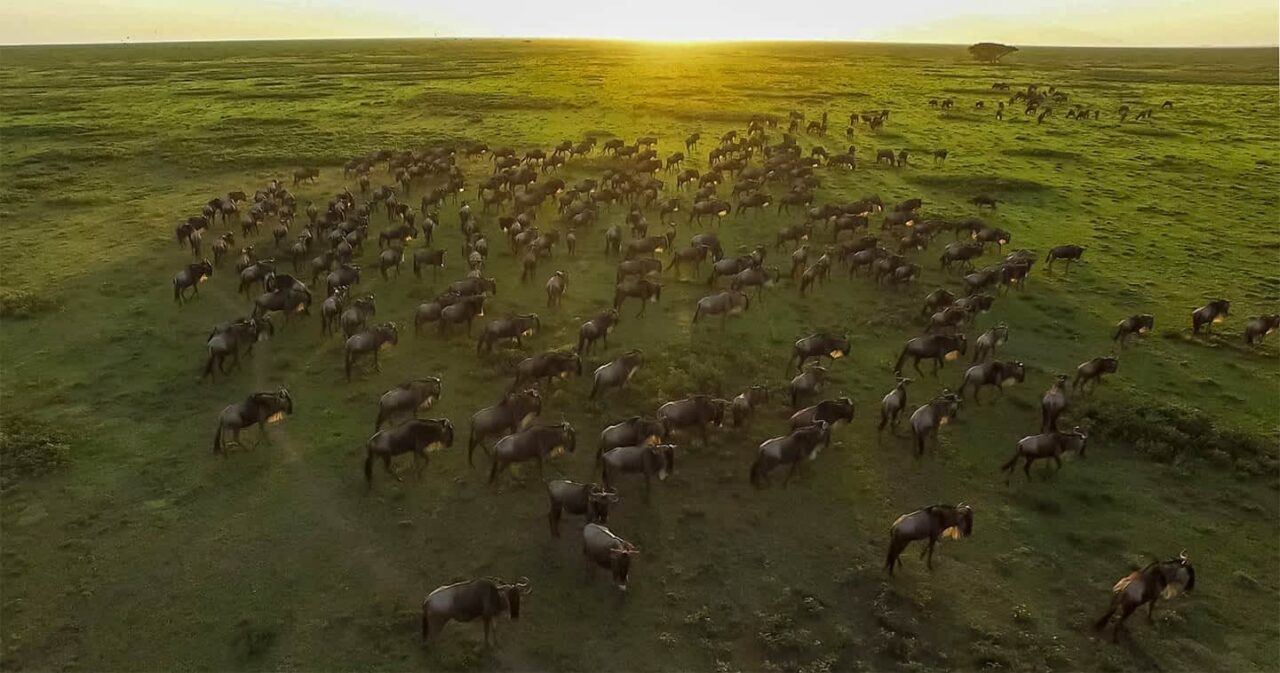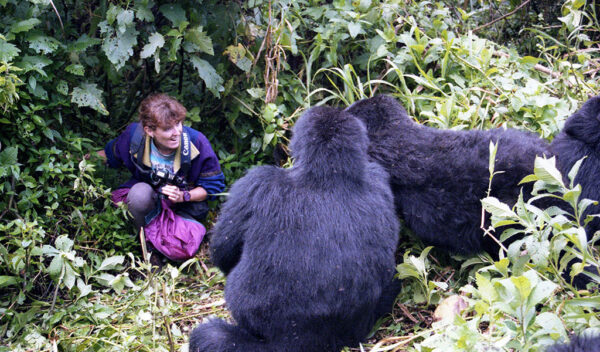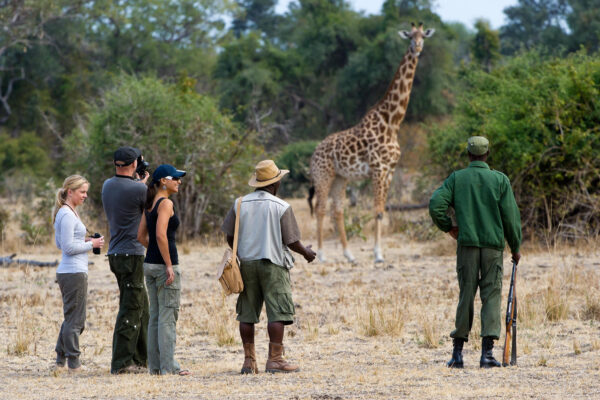
How Far Do I Need to Walk to See Chimpanzees?
November 25, 2025How Does Golden Monkey Tracking Support Conservation?
November 26, 2025How Does the Migration Route Change Every Year?
When travelers ask, “How does the migration route change every year?”, they are delving into one of the most extraordinary wildlife phenomena on the planet—the Great Migration. This annual movement of millions of wildebeest, zebras, and other herbivores across Kenya and Tanzania is not just a wildlife spectacle; it is a dynamic ecological event that shapes the landscapes, sustains predator populations, and influences tourism in East Africa. At Renai Safaris, we specialize in crafting immersive Kenya Safaris, Tanzania Safaris, and Rwanda Gorilla Trekking Safaris that allow travelers to witness this awe-inspiring natural phenomenon while exploring the region’s diverse wildlife and cultural heritage.
Introduction: Understanding the Dynamics of East Africa’s Great Migration
The Great Migration is inherently fluid. Driven by rainfall, grass availability, and water sources, the herds move through the Serengeti in Tanzania and the Maasai Mara in Kenya, often shifting routes year to year depending on environmental conditions. Understanding how the migration route changes every year allows safari operators to design the most effective itineraries for Kenya Wildlife Safaris, Tanzania Wildlife Safaris, and specialized tours like Tanzania Chimpanzee Tracking Safaris. Beyond wildlife observation, these safaris often integrate cultural experiences, such as visiting Maasai communities, witnessing traditional dances, or exploring the local arts and crafts.
At Renai Safaris, we ensure that travelers not only witness the migration but also gain insights into the ecological factors influencing it. This includes how droughts, rains, and conservation practices alter the migration pathways annually, and how these changes affect wildlife distribution, predator-prey dynamics, and birding opportunities on Kenya Birding Safaris. For those combining their safari with Uganda Gorilla Trekking, understanding the Great Migration’s movement patterns ensures a seamless multi-country adventure.
The Ecological Drivers of Migration Changes
One of the most common questions asked is, “Why does the migration route change every year?” The answer lies in the intricate relationship between wildlife and the environment. The Great Migration is driven primarily by the search for fresh grazing and water. Variations in rainfall, drought patterns, and vegetation growth influence where the herds move. For example, in years of early rains, wildebeest may arrive in northern Serengeti plains earlier than usual, while delayed rains might push them further south or into less frequented areas of Tanzania.
This dynamic movement is critical for safari planners. Understanding how the migration route changes every year allows travelers on Kenya Best Safaris or Tanzania Best Safaris to anticipate where wildlife concentrations will be highest, ensuring optimal sightings of predator-prey interactions, calving events, and river crossings. At Renai Safaris, our expert guides monitor rainfall patterns, satellite imagery, and park reports to track herd movements, guaranteeing guests experience the Great Migration in its full grandeur.
Environmental factors also impact associated wildlife. For instance, predator behavior, such as lion and hyena hunting strategies, shifts according to herd location. Bird populations respond to seasonal grazing patterns, enhancing the appeal of Kenya Birding Safaris or Tanzania Birding Safaris. Understanding these interdependencies is crucial for travelers seeking not only a Kenya Wildlife Safari but also a holistic experience encompassing both fauna and flora.
Moreover, Renai Safaris encourages combining migration viewing with Rwanda Gorilla Trekking Safaris or Tanzania Chimpanzee Tracking Safaris, creating itineraries that blend savannah, forest, and primate adventures. Observing how the migration adapts yearly highlights the resilience of East Africa’s ecosystems and reinforces the importance of conservation and community involvement.
Seasonal Shifts and Their Impact on Safari Planning
Travelers frequently ask, “How do seasonal changes influence the migration route and safari planning?” The Great Migration follows a natural cycle that is closely linked to the region’s rainy and dry seasons. In Tanzania, the migration typically begins in the southern Serengeti around Ndutu and the Ngorongoro Conservation Area during the calving season (December to March). As the dry season progresses (June to October), herds move northward toward the Mara River and the Maasai Mara in Kenya.
Understanding how the migration route changes every year is essential for scheduling Kenya Safaris or Tanzania Safaris to coincide with key events such as river crossings or calving. The timing of these events can fluctuate slightly each year due to rainfall patterns, making real-time knowledge and expert guidance crucial for successful safari planning. For instance, river crossings, which are among the most dramatic migration spectacles, may occur earlier or later depending on water levels and herd movement.
For safari enthusiasts, combining migration-focused safaris with other experiences enriches the journey. Guests on Kenya Wildlife Safaris can witness predators stalking herds in the Mara, then travel to Tanzania for a Tanzania Chimpanzee Tracking Safari, followed by Rwanda Gorilla Trekking Safaris. This approach offers multi-dimensional wildlife experiences and ensures that travelers witness the migration’s annual variability firsthand, all while engaging with local communities and cultural sites.
By highlighting the seasonal shifts in migration routes, Renai Safaris empowers travelers to make informed decisions about when and where to experience the Great Migration, ensuring both safety and maximum wildlife viewing opportunities.
Regional Variations in Migration Routes
Another key question is, “Do migration routes differ between Kenya and Tanzania?” Indeed, the Great Migration is not a fixed path but a fluid movement influenced by regional variations in geography, rainfall, and grass growth. In Tanzania, herds favor the southern Serengeti plains and Ngorongoro Conservation Area during the calving season, while in Kenya, they congregate along the Mara River for crossings between July and September.
Understanding how the migration route changes every year requires considering these regional nuances. Some years, herds may spread wider across the Serengeti due to abundant rainfall or move earlier to northern grazing grounds in the Maasai Mara. These fluctuations affect safari planning for Kenya Best Safaris, Tanzania Best Safaris, and birding-focused adventures like Kenya Birding Safaris, where the presence of grazers influences bird populations.
Renai Safaris leverages local knowledge to provide travelers with predictive insights about herd movements. This includes information on predator concentrations, preferred grazing zones, and river crossing hotspots. For those combining Rwanda Gorilla Trekking Safaris or Tanzania Chimpanzee Tracking Safaris, these predictions allow for coordinated itineraries that maximize wildlife viewing across multiple ecosystems, blending savannah, forest, and mountainous habitats.
By considering regional variations, travelers gain a deeper understanding of East Africa’s ecological complexity. This knowledge enhances their safari experience and underscores the critical role of adaptive planning in observing one of the world’s most iconic wildlife spectacles.
The Role of Conservation in Migration Patterns
Travelers increasingly ask, “How do conservation efforts influence how the migration route changes every year?” Protected areas, anti-poaching initiatives, and community-based conservation projects play a pivotal role in shaping the paths of migrating herds. Parks like Serengeti National Park, Maasai Mara, and Ngorongoro Conservation Area provide secure corridors for animals to move freely, minimizing human-wildlife conflict and ensuring the migration’s sustainability.
At Renai Safaris, we emphasize that understanding how the migration route changes every year is incomplete without recognizing conservation’s impact. Community conservancies in Kenya, for example, safeguard grazing lands, allowing herds to follow traditional routes while benefiting local populations economically through tourism revenue. Similarly, in Tanzania, wildlife corridors connecting the Serengeti with Ngorongoro and surrounding areas are maintained to facilitate seasonal movement, supporting predator-prey dynamics and biodiversity.
Conservation also influences safari experiences. Travelers on Kenya Wildlife Safaris, Tanzania Wildlife Safaris, or Tanzania Chimpanzee Tracking Safaris experience healthier ecosystems with richer wildlife encounters because of protected habitats. Combining these safaris with Rwanda Gorilla Trekking Safaris demonstrates how integrated conservation efforts across countries can enhance both biodiversity protection and tourism benefits, offering guests a comprehensive and responsible African adventure.
Ultimately, observing how the migration adapts each year reinforces the importance of sustainable tourism and conservation, ensuring that future generations can witness this remarkable natural phenomenon.
Combining Migration Safaris with Multi-Country Adventures
Many travelers ask, “Can I combine migration safaris with gorilla trekking or other wildlife experiences?” The answer is a resounding yes. The flexibility of Kenya Safaris and Tanzania Safaris allows for seamless integration with Uganda Gorilla Trekking Safaris, Rwanda Gorilla Trekking Safaris, and Tanzania Chimpanzee Tracking Safaris.
Combining migration-focused safaris with gorilla trekking or chimpanzee tracking offers multi-dimensional wildlife encounters. Guests can witness dramatic river crossings and predator-prey interactions in Kenya or Tanzania, then travel to Uganda or Rwanda for intimate jungle treks to observe mountain gorillas. These combined itineraries enrich the safari experience, providing travelers with varied ecosystems, species diversity, and cultural engagement.
Additionally, cultural immersion complements wildlife experiences. Travelers can visit Maasai villages, participate in traditional dances, and learn about local crafts along the migration route. Renai Safaris ensures these itineraries are ethically designed, balancing adventure, cultural exchange, and conservation awareness. Understanding how the migration route changes every year enhances these multi-country safari plans by providing insight into optimal timing and locations for maximum wildlife encounters.
This approach positions East Africa as the ultimate destination for wildlife enthusiasts, offering not just a safari but a transformative journey across multiple ecosystems, cultures, and countries.
Conclusion: Mastering the Timing of East Africa’s Great Migration
Answering “How does the migration route change every year?” reveals the intricate interplay of rainfall, grazing patterns, conservation efforts, and regional ecological dynamics. At Renai Safaris, we use this knowledge to craft meticulously timed Kenya Safaris, Tanzania Safaris, and multi-country adventures including Uganda Gorilla Trekking Safaris and Rwanda Gorilla Trekking Safaris, ensuring that travelers experience the migration at its peak.
By understanding migration patterns, guests can witness dramatic river crossings, calving seasons, and predator-prey interactions while also engaging in Kenya Birding Safaris, Tanzania Chimpanzee Tracking Safaris, and Kenya Cultural Safaris. This holistic approach transforms a safari from a wildlife observation trip into an educational, immersive, and socially responsible adventure.
Ultimately, the changing routes of the Great Migration are not a limitation but an invitation to explore East Africa’s dynamic landscapes, witness nature’s resilience, and participate in conservation-conscious tourism. With Renai Safaris, every journey is a carefully curated experience, offering insights into one of the planet’s most remarkable natural spectacles and ensuring memories that last a lifetime.





